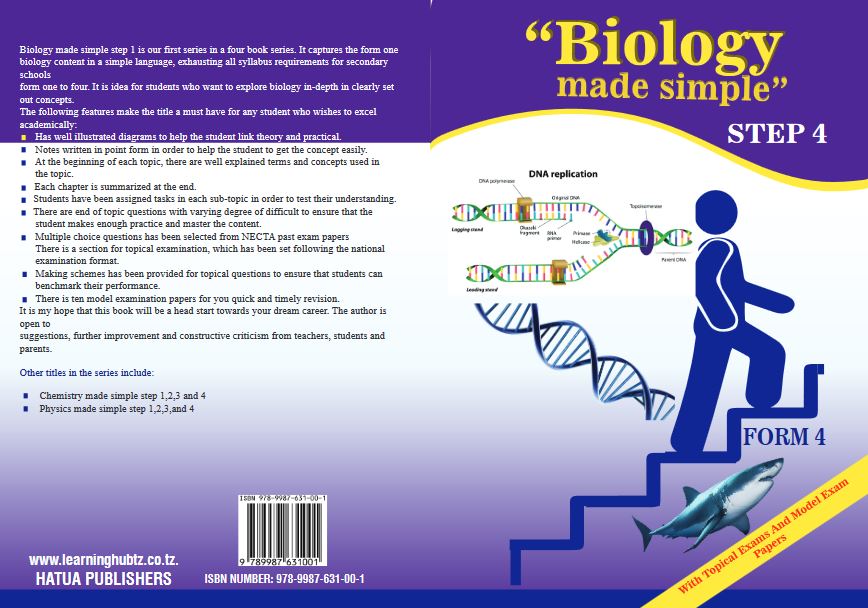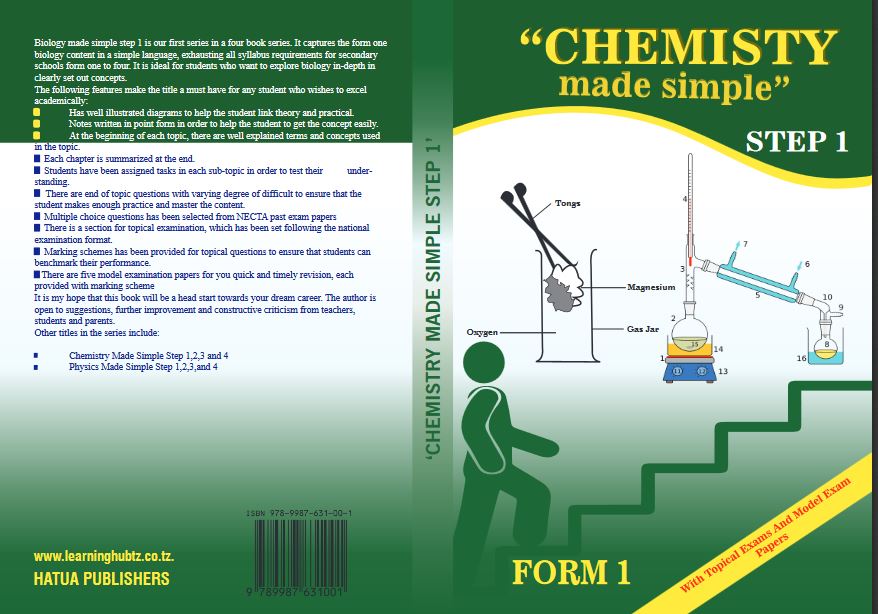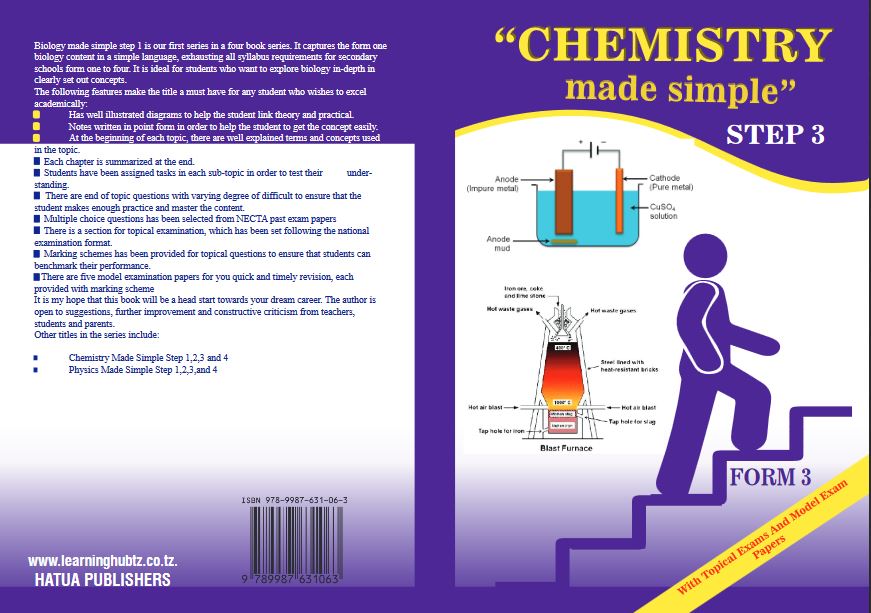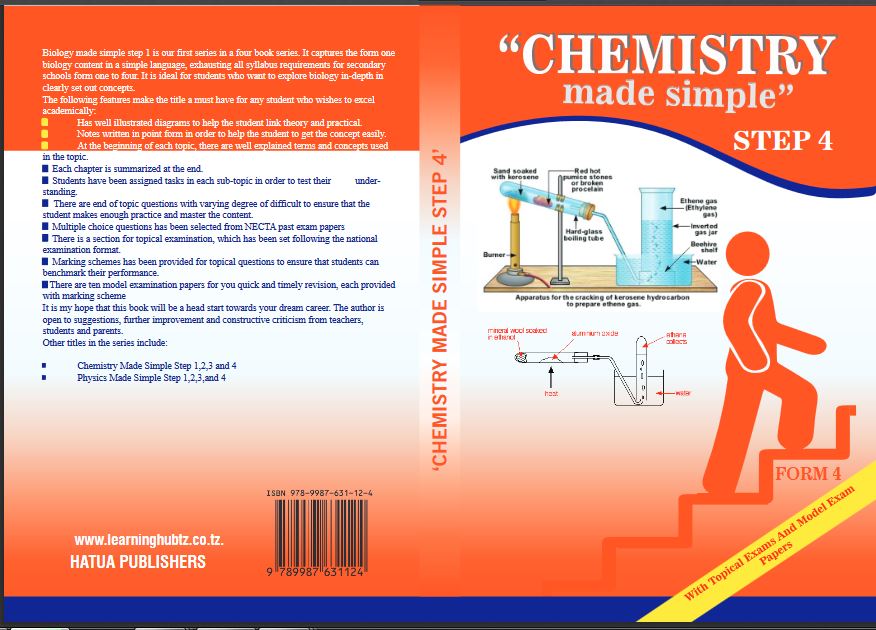THE UNITED REPUBLIC OF TANZANIA NATIONAL EXAMINATIONS COUNCIL OF TANZANIA
FORM TWO NATIONAL ASSESSMENT
032 CHEMISTRY
Time: 2:30 HoursYear: 2020
Instructions
1. This paper consists of sections A and B with a total of ten (10) questions.
2. Answer all questions in the spaces provided.
3. Section A carries twenty (20) marks and section B carries eighty (80) marks.
4. All writing must be in black or blue ink except diagrams which must be in pencil.
5. Cellular phones and any unauthorised materials are not allowed in the assessment room.
6. Write your Assessment Number at the top right corner of every page.
7. The following atomic masses may be used: H = 1, N = 14, 0 = 16, S = 32, Ca = 40.
SECTION A (20 Marks)
Answer an questions in this section.
I .For each of the items (1) (x), choose the correct answer from among the given alternatives and write its letter in the box provided.
(i) The net charge inside the nucleus of an atom is contributed by
- protons
- neutrons
- electrons
- all nucleons.
(ii) Why oxygen as one of the components of air is unique?
- It support combustion.
- It is a diatomic gas.
- It forms the largest part of the air.
- It has the largest density.
(iii) Which material is not involved in respiration?
- Carbon dioxide
- Nitrogen
- Oxygen
- Water
(iv) Which element causes permanent hardness of water when combined with sulphate?
- aluminium
- magnesium
- potassium
- sodium.
(v) Carbon dioxide. Oxygen, Nitrogen and Hydrogen Sulphide are
- major components of air.
- covalent compounds.
- divalent gases.
- ionic compounds.
(vi) Which common feature is associated with elements of the same group?
- Equal number of protons
- Equal number of electrons
- Equal number of valence electrons
- Equal number of shells.
(vii) The oxidation state of metallic elements is always
- negative
- Neutral
- positive
- zero.
(viii) An isotope of Lead with atomic number of 82 and mass number of 207 has
- 82 protons, 125 neutrons and 82 electrons.
- 25 protons, 82 neutrons and 125 electrons.
- 82 protons, 207 neutrons and 125 electrons.
- 207 protons, 207 electrons and 82 neutrons.
(ix) Which conditions are necessary for iron nails to rust?
- oxygen and moisture
- carbon and oxygen
- carbon dioxide and oxygen
- oxygen and nitrogen.
(x) Which decision should be made if the results of an experiment do not support the stated hypothesis?
- To use the results as an idea for further testing.
- To ignore the results and set a new experiment.
- To repeat the experiment in the same way.
- To identify a new problem.
7. (a)Why is petrol not recommended to be used as fuel in school laboratories? Briefly explain.
View Ans(b) Which three heat sources can be used to boil some water in the laboratory instead of the Bunsen burner?
View Ans(c) Arrange the following steps for lighting the Bunsen burner in a correct sequence using letter
A to F.
- Turn the collar to close the air hole completely.
- Turn on the gas fully to ensure that plenty of gas is entering the burner.
- Connect the Bunsen burner to the gas mains.
- Adjust the gas tap until the supply of gas is enough for a time.
- Light the gas at the top of the barrel with a lighted matchstick.
- Close the air hole.
Answer
| Step | 1 | 2 | 3 | 4 | 5 | 6 |
| Letter |
8. (a)Giving a reason, state whether rust will form or not in each of the situations (i) - (vi).
- Iron bar is dipped into boiling water.
- Painted iron bar is dipped into un-boiled water.
- Iron bar is dipped in un-boiled water.
- Oiled iron bar is left outside the room over nights.
- Aluminium wire is dipped in un-boiled water.
- A dry iron bar is wrapped with cotton wool.
(b)Briefly explain any four methods of preventing rusting.
View Ans9(a)Write chemical formulae of the two compounds from which oxygen gas can be prepared by decomposition.
View Ans(b)What are the three physical properties of oxygen gas?
View Ans(c) Why is it important to have abundant oxygen gas on the Earth? Give five reasons.
View Ans10. Identify the five accidents which are common in the laboratory and in each explain possible causes and preventive measures to be taken.
View AnsTHE UNITED REPUBLIC OF TANZANIA NATIONAL EXAMINATIONS COUNCIL OF TANZANIA
FORM TWO NATIONAL ASSESSMENT
032 CHEMISTRY
Time: 2:30 HoursYear: 2020
Instructions
1. This paper consists of sections A and B with a total of ten (10) questions.
2. Answer all questions in the spaces provided.
3. Section A carries twenty (20) marks and section B carries eighty (80) marks.
4. All writing must be in black or blue ink except diagrams which must be in pencil.
5. Cellular phones and any unauthorised materials are not allowed in the assessment room.
6. Write your Assessment Number at the top right corner of every page.
7. The following atomic masses may be used: H = 1, N = 14, 0 = 16, S = 32, Ca = 40.
SECTION A (20 Marks)
Answer an questions in this section.
I .For each of the items (1) (x), choose the correct answer from among the given alternatives and write its letter in the box provided.
(i) The net charge inside the nucleus of an atom is contributed by
- protons
- neutrons
- electrons
- all nucleons.
(ii) Why oxygen as one of the components of air is unique?
- It support combustion.
- It is a diatomic gas.
- It forms the largest part of the air.
- It has the largest density.
(iii) Which material is not involved in respiration?
- Carbon dioxide
- Nitrogen
- Oxygen
- Water
(iv) Which element causes permanent hardness of water when combined with sulphate?
- aluminium
- magnesium
- potassium
- sodium.
(v) Carbon dioxide. Oxygen, Nitrogen and Hydrogen Sulphide are
- major components of air.
- covalent compounds.
- divalent gases.
- ionic compounds.
(vi) Which common feature is associated with elements of the same group?
- Equal number of protons
- Equal number of electrons
- Equal number of valence electrons
- Equal number of shells.
(vii) The oxidation state of metallic elements is always
- negative
- Neutral
- positive
- zero.
(viii) An isotope of Lead with atomic number of 82 and mass number of 207 has
- 82 protons, 125 neutrons and 82 electrons.
- 25 protons, 82 neutrons and 125 electrons.
- 82 protons, 207 neutrons and 125 electrons.
- 207 protons, 207 electrons and 82 neutrons.
(ix) Which conditions are necessary for iron nails to rust?
- oxygen and moisture
- carbon and oxygen
- carbon dioxide and oxygen
- oxygen and nitrogen.
(x) Which decision should be made if the results of an experiment do not support the stated hypothesis?
- To use the results as an idea for further testing.
- To ignore the results and set a new experiment.
- To repeat the experiment in the same way.
- To identify a new problem.
2. (a)Match each item in List A with a correct response in List B by writing the letter of the correct response below the corresponding item number in the table provided.
| List A | List B |
| (i) An element with atomic number (ii) The type of bonding which occurs between non metals. (iii) Elements in the Periodic Table found in groups IV to VII. (iv) Vertical columns of the Periodic Table. (v) Elements which react vigorously with water |
|
(b) Answer the given questions by writing the correct answer in the blank spaces provided.
(i) In which stage is the hypothesis tested during scientific investigation? . . . . . . . . . . . . . . . . .
(ii) On which factor does the physical state of a molecule depend? . . . . . . . . . . . . . . . . .
(iii) Which properties depend on the proportions of mixing substances in a mixture? . . . . . . . . . . . . . . . . .
(iv) What are the building blocks of matter? . . . . . . . . . . . . . . . . .
(v) Which particles are transferred during chemical reactions? . . . . . . . . . . . . . . . . .
View Ans
SECTION B (80 Marks)
Answer all questions in this section.
3. (a) Why candles are not suitable for heating in the laboratory? Give two reasons.
View Ans(b) Differentiate luminous from non-luminous flame by giving five points.
View Ans4. (a) State four main ideas of the Dalton's atomic theory of matter.
View Ans(b)Classify each of the following elements into their respective groups and periods.
| SIN | Element | Group | Period |
| (i) | Calcium |
|
|
| (ii) | Hydrogen |
|
|
| (iii) | Chlorine |
|
|
| (iv) | Boron |
|
|
| (v) | Aluminium |
|
|
5. (a)With an example for each, give two fields in which the scientific procedure is applied.
View Ans(b) Categorize the three factors (variables) which affect the problem being investigated during scientific investigation.
View Ans6, (a) Briefly explain why:
(i) the use of charcoal is harmful to the environment.
(ii)charcoal is still being used by majority of Tanzanians for domestic purposes.
View Ans(b) A mass of 20.0 g of petrol was burnt in air. The heat produced was used to heat 2.5 litres of water. Given that the heat value of petrol is 43,640 kJ/kg, by how much the temperature of water could have changed? (The specific heat capacity of water = 4.18 Id kg-1 K-1, Density of water = 1000 kg/m3).
View Ans7. (a)Why is petrol not recommended to be used as fuel in school laboratories? Briefly explain.
View Ans(b) Which three heat sources can be used to boil some water in the laboratory instead of the Bunsen burner?
View Ans(c) Arrange the following steps for lighting the Bunsen burner in a correct sequence using letter
A to F.
- Turn the collar to close the air hole completely.
- Turn on the gas fully to ensure that plenty of gas is entering the burner.
- Connect the Bunsen burner to the gas mains.
- Adjust the gas tap until the supply of gas is enough for a time.
- Light the gas at the top of the barrel with a lighted matchstick.
- Close the air hole.
8. (a)Giving a reason, state whether rust will form or not in each of the situations (i) - (vi).
- Iron bar is dipped into boiling water.
- Painted iron bar is dipped into un-boiled water.
- Iron bar is dipped in un-boiled water.
- Oiled iron bar is left outside the room over nights.
- Aluminium wire is dipped in un-boiled water.
- A dry iron bar is wrapped with cotton wool.
(b)Briefly explain any four methods of preventing rusting.
View Ans9(a)Write chemical formulae of the two compounds from which oxygen gas can be prepared by decomposition.
View Ans(b)What are the three physical properties of oxygen gas?
View Ans(c) Why is it important to have abundant oxygen gas on the Earth? Give five reasons.
View Ans10. Identify the five accidents which are common in the laboratory and in each explain possible causes and preventive measures to be taken.
View AnsANSWER

Hub App
 For Call,Sms&WhatsApp: 255769929722 / 255754805256
For Call,Sms&WhatsApp: 255769929722 / 255754805256
 For Call,Sms&WhatsApp: 255769929722 / 255754805256
For Call,Sms&WhatsApp: 255769929722 / 255754805256
WHATSAPP US NOW FOR ANY QUERY
App Ya Learning Hub Tanzania





